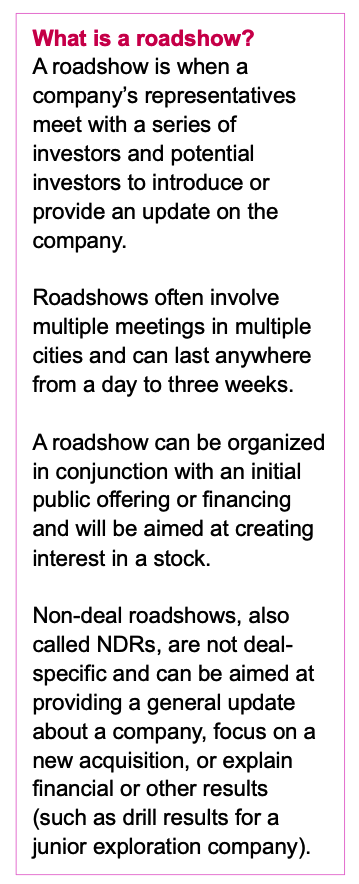 Annemarie Brissenden, CPIR
Annemarie Brissenden, CPIR
If you’re having a hard time finding new names to add to your shareholder register, you’re not alone.  It’s becoming increasingly difficult to land that unicorn: a new investor who’s never heard of you and would be a good fit for your story. Landing on the formula for organizing a successful roadshow, once a tried-and-true way to broaden your shareholder base, is proving to be just as elusive.
It’s becoming increasingly difficult to land that unicorn: a new investor who’s never heard of you and would be a good fit for your story. Landing on the formula for organizing a successful roadshow, once a tried-and-true way to broaden your shareholder base, is proving to be just as elusive.
“I’m having lots of conversations around how to diversify shareholder base and get new names into the story,” said Lisa Wilkinson, Vice President of Investor Relations and Corporate Communications at Centerra Gold Inc. “It feels like everyone is going to the same conferences and talking to the same people, whether it’s a [major investor centre] or an established conference.”
Siren Fisekci, Vice President, Investor Relations and Corporate Communications at Pan American Silver Corp., agreed.
“I think that the tendency to meet with the same individuals is something that IROs struggle with to a big degree in terms of targeting new shareholders,” said the 2024 CIRI Fellow. “That’s why it’s always a constant theme.”
However, they both emphasized that flexibility and diversity are key to planning a roadshow that yields new contacts. You need to keep your options open, which means working with a combination of corporate access teams, sell-side analysts and independent third parties with large networks.
It’s helpful to start with what you’re trying to achieve, and then determine which approach best suits those goals.
For example, when you work with sell-side analysts, part of your goal might be maintaining your relationships with them and supporting their coverage. You may not meet new investors or get nuanced feedback, but it can be a good way to catch up with existing shareholders and make sure they are up to date on your company’s story.
Working with a broker and the broker’s corporate access team can be great in the lead-up to a financing. It will give you a chance to evaluate the team and see if it is a good fit for your company. You’re also more likely to get more nuanced, actionable feedback and, as when you work with an analyst, there isn’t a cost for setting up the meetings.
Keep in mind, though, that brokers, analysts and their corporate access teams aren’t working for free. Their payback comes when one of their clients purchases or trades the stock. So they aren’t incentivized to set up meetings with people or institutions that aren’t on their client list.
When you work with independent third parties, you’re basically  paying a fee to access their networks. That fee might take the form of a retainer for a minimum period (three, six, or even 12 months), a set amount per meeting, or a set amount per location (e.g. a day of marketing in London that might include a breakfast, a lunch and several one-on-ones). Some independent parties include the cost of any meals in their fee; others expect you to pay for the meals on top of their fee.
paying a fee to access their networks. That fee might take the form of a retainer for a minimum period (three, six, or even 12 months), a set amount per meeting, or a set amount per location (e.g. a day of marketing in London that might include a breakfast, a lunch and several one-on-ones). Some independent parties include the cost of any meals in their fee; others expect you to pay for the meals on top of their fee.
For nano- and micro-cap companies without analyst coverage or brokerage sponsorship, this has been a traditional avenue for meeting new investors and building out the shareholder base. What’s changed is that more and more larger cap companies are turning to this approach, even though it can be quite costly.
That’s why it’s important, particularly when working with independent third parties, to keep some useful tips in mind:
- One size does not fit all – one firm might have a well-developed network in one city, but not in another. Ask for references and don’t be afraid to use different firms for different cities.
- If you’ve worked with the same firm for one or two years, you might have reached the bottom of its network. It could be time to start working with someone new.
- Ask for the firm’s target list before the firm starts to set up meetings; set a target for the percentage of meetings that should be with people you haven’t met with before.
- Don’t be afraid to backfill. If you’re going to a conference or working with a broker, consider working with a third party to fill gaps or add a day in a nearby city. Just make sure you’re not cannibalizing conference attendees or having two firms chasing the same pool of investors.
- Leverage and build your own network by asking your existing shareholders if there’s anyone you should meet with or encouraging investors to bring an investor friend to your event.
- Always ask for feedback. Did the meetings go well, were people engaged, are they going to follow the story and take a position – why or why not?
Most importantly, don’t be afraid to try new things for a small fee: schedule a lunch and learn with brokers in a smaller market, for example, or go on the road with a newsletter writer in a new-to-you market. One-off, non-retainer engagements can be a great way to evaluate the network and approach of a new service provider while making a minimal commitment.
It’s an approach that Dmitry Kushnir, Vice President of Investor Relations at Star Royalties Ltd., has embraced for delivering regular updates to the market.
“We don’t do conference calls because we’re not covered,” he said. “But I line up investor updates on a quarterly basis with different vendors, so it works out to providing a regular quarterly update.”
Many people are trying to build out their own roadshow schedule by reaching out to a target list they’ve generated internally, but in the main, the results are underwhelming.
For Kushnir, doing an email campaign before marketing in a city to try and judge if there is value there can be a lot like online dating: lots of outreach with little to no response. “It’s a one-way street.”
Fisekci spoke of a similar experience. “Even people [who seem to] have initiated a position and haven’t met with us don’t reply to outreach,” she said. “Zero response to an email. Maybe once in a blue moon, I get the no thanks. PMs get multitudes of emails, so if they don’t recognize the name, they just don’t respond.”
That’s why the intermediary with strong existing relationships has become so important.
As Lauren Megaw, Vice President of Corporate Development for Reyna Silver, said: “It’s all about finding quality people who have niche networks that resonate with your story.”
She also tries to keep different types of investors together and avoids – where possible – large groups that mix technical people, generalists and the dreaded seat fillers who are just there for a free and fancy meal.
“It does mean that your cost per meeting goes up, but it’s the quality versus quantity,” said Megaw. “Especially if that allows me to create a relationship that I can follow up with, that makes such a difference.”
At the end of the day, planning and executing a successful roadshow is more an art than a science. For Quentin Weber, CPIR, who oversees investor relations for WSP Global Inc., the “main takeaway is to be flexible and have a diversified approach, leveraging all available tools in your planning.”
Annemarie Brissenden, CPIR, is the Director, Investor Relations for Refined Substance Inc.